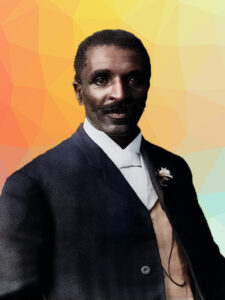Occupation
Agricultural Scientist and Inventor
Birth/Death Dates
1861 or 1864 – January 5, 1943
Summary
George Washington Carver was an American agricultural scientist and inventor who promoted alternative crops to cotton and methods to prevent soil depletion. He was one of the most prominent black scientists of the early 20th century.
While a professor at Tuskegee Institute, Carver developed techniques to improve types of soils depleted by repeated cotton plantings. He encouraged poor farmers to grow other crops, such as peanuts and sweet potatoes, as a source of their own food and to improve their quality of life. The most popular of his 44 practical bulletins for farmers contained 105 food recipes using peanuts.
In addition to his work to improve the lives of farmers, Carver was a leader in promoting environmentalism. He received numerous honors for his work, including the Spingarn Medal of the NAACP. In an era of high racial polarization, his fame reached beyond the black community. He was widely recognized and praised in the white community for his many achievements and talents. In 1941, Time magazine dubbed Carver a “Black Leonardo”.
Educational Background
Carver was accepted at Highland University in Highland, Kansas, but when he arrived, they refused to let him attend because of his race.
He studied art and piano at Simpson College in Indianola, Iowa. His art teacher there recognized his talent for painting flowers and plants and encouraged him to study botany at Iowa State Agricultural College (now Iowa State University) in Ames, Iowa. When he began there in 1891, he was the first black student at Iowa State. He received a bachelor’s degree in 1894 and a Master of Science degree in 1896. Carver taught as the first black faculty member at Iowa State.
Carver did not have an earned doctorate, but both Simpson College and Selma University awarded him honorary doctorates of science in his lifetime and Iowa State awarded him a posthumous Humane Letters degree in 1994.
Struggles This Inventor Overcame
Carver was born into slavery in Diamond Grove, (now Diamond, Newton County, Missouri). After slavery was abolished, his enslaver, Moses Carver, and his wife, Susan, raised George and his older brother, James, as their own children. They encouraged George to continue his intellectual pursuits.
The Problem That This Inventor Solved
• Improved types of soils depleted by repeated plantings of cotton.
• Improved the lives of poor farmers.
How This Inventor Changed the World
In 1896, Booker T. Washington, the first principal and president of the Tuskegee Institute (now Tuskegee University), invited Carver to head its Agriculture Department. Carver taught there for 47 years, developing the department into a strong research center and working with two additional college presidents during his tenure. He taught methods of crop rotation, introduced several alternative cash crops for farmers that would also improve the soil of areas heavily cultivated in cotton, initiated research into crop products (chemurgy), and taught generations of black students farming techniques for self-sufficiency.
Lasting Impact
Carver developed techniques to improve soils depleted by repeated plantings of cotton. Together with other agricultural experts, he urged farmers to restore nitrogen to their soils by practicing systematic crop rotation: alternating cotton crops with plantings of sweet potatoes or legumes, such as peanuts, soybeans, and cowpeas. These crops both restored nitrogen to the soil and were good for human consumption. The crop rotation practice resulted in improved cotton yields and gave farmers alternative cash crops.






